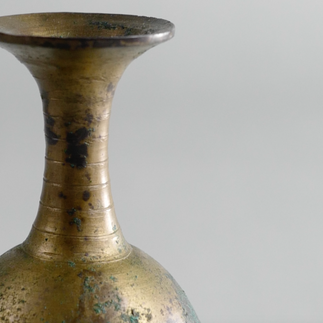展覽筆記 vol.13 北齊 響銅淨瓶:《松心蒼翠》南北朝特展 - A Bronze Kundika Vase Northern Qi Dynasty, Lam's Gallery.
- SACA
- Mar 28, 2024
- 3 min read
Updated: Mar 30, 2024

北齊 響銅淨瓶
來源:古美術いづみ,東京。
這種花瓶的形狀很可能源自印度的例子,用於在儀式上灑水和其他酒水。這種花瓶隨佛教傳入中國,經常出現在菩薩手中,尤其是觀音菩薩。這種器皿的中文名稱之一是 "觀音瓶"。
美國紐約大都會博物館有一件與本品類似,但是沒有頸部弦紋的同類瓶子。
美國大都會博物館:
北齊 青銅淨瓶
Title: Bottle
Period: Northern Qi dynasty (550–577)
Culture: China
Medium: Bronze
Dimensions: H. 6 1/8 (15.6 cm); Diam. of rim (1 7/16 in. (3.7 cm); Diam. of foot (1 15/16 in. (4.9 cm)
Classification: Metalwork
Credit Line: Gift of James Freeman, 2002
Accession Number: 2002.290
The shape of this vase most likely derives from Indian examples used to sprinkle water and other libations during ceremonies. Such vessels were introduced to China with Buddhism and can often be seen in the hands of bodhisattvas, particularly Avalokiteshvara (Guanyin). One of the Chinese names for vessels of this type is Guanyin ping, or “Avalokiteshvara vase.”


常盤山文庫《北齊陶瓷》書中參考:

松心蒼翠
松心閣很高興推出第二期主題線上展覧「松心蒼翠」。南北朝时期(439-589 年)形勢混亂動盪、災難連綿,不但考驗了人性的堅韌,也催生了頂級藝術的誕生。
南北朝的美是不同文化交融、碰撞、綻放的美。當中佛教的興起令與其相關的圖案在中國流行起来,象徵佛教的蓮花常被用作器皿的形状和图案;而南方的青瓷也廣被北方接受。在中国陶瓷史上,青瓷釉料的生产越来越广泛,這是一個中國藝術史上十分關鍵,承上啟下的時代。

這時代的中國,不同材質的藝術品如一場絢爛的煙花,其深度、廣度奠定了南北朝在中國藝術史中的不可撼動的地位。匠人們在一次次的不確定性中以發自內心的真切之美作為抵抗,而這種默默無言,源自人性堅韌的精神力量,浩瀚磅礴,穿透時間,撼動心靈。
這無疑是一個值得被研究學習的時代,松心閣希望透過是次「松心蒼翠南北朝特別展覽」與大家一起分享這時代的不同文物,我們誠邀您通過以下網址與我們一起踏上南北朝之旅:https://lams-gallery.com/ (复制黏贴至浏览器,或者点击文章底部左下角“阅读原文”。
— 松心閣
閱讀寶榜發布的《松心蒼翠》文章:https://mp.weixin.qq.com/s/Y9LeomHo5p9MYKksUtEqbw
Download the Exhibition Catalogue:

A BRONZEKUNDIKA VASE
NORTHERN QI DYNASTY (550 - 577)
13.7cm
Provenance:
Gallery Izumi, Tokyo
The shape of this vase most likely derives from Indian examples used to sprinkle water and other libations during ceremonies. Such vessels were introduced to China with Buddhism and can often be seen in the hands of bodhisattvas, particularly Avalokiteshvara (Guanyin). One of the Chinese names for vessels of this type is Guanyin ping, or “Avalokiteshvara vase.”
A similar collection without the strings feature for the neck, is in the Metropolitan Museum of Art, New York.
Eternal Dynasties
a Special Exhibition of Northern & Southern Dynasties
The North and South Dynasties (439-589) were a period of chaos and disaster, which not only tested the resilience of human nature, but also gave rise to the birth of top-notch art.
The beauty of the Northern and Southern Dynasties is the beauty of different cultures that blossomed through the fusion and collision of several cultures. The rise of Buddhism led to the popularization of motifs related to Buddhism in China, with the lotus flower, a symbol of Buddhism, often used as the shape and motif of vessels of that period; during which time celadon from the south was also widely accepted in the north. The production of celadon glazes became increasingly widespread in Chinese ceramics, and this was a pivotal era in the history of Chinese art, a time of transition from the past to the present.
The depth and breadth of the fireworks display of different materials in China during this era established the North and South Dynasties as an unassailable part of Chinese art history. Craftsmen resisted the uncertainty time and again with the true beauty of their hearts, and this silent, spiritual power, originating from the resilience of human nature, is so vast and majestic that it penetrates time and shakes the minds of their contempory audiences.
This is undoubtedly an era that deserves to be studied. Through this "Northern and Southern Dynasties Special Exhibition", Lam's Gallery hopes to share with you the different artifacts of this era. We sincerely invite you to embark on a journey of the time and beauty with us through the following website: https://lams-gallery.com/
- Midco Lam, Lam's Gallery




























Comments